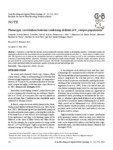Please use this identifier to cite or link to this item:
http://www.alice.cnptia.embrapa.br/alice/handle/doc/940838| Title: | Phenotypic correlations between combining abilities of F2 cowpea populations. |
| Authors: | CARVALHO, L. C. B.  SILVA, K. J. D. e   ROCHA, M. de M.   SOUSA, M. B. de   PIRES, C. de J.   NUNES, J. A. R.   |
| Affiliation: | LEONARDO CASTELO BRANCO CARVALHO, UFPI; KAESEL JACKSON DAMASCENO E SILVA, CPAMN; MAURISRAEL DE MOURA ROCHA, CPAMN; MASSAINE BANDEIRA DE SOUSA, UFPI; CAROLLINE DE JESÚS PIRES, UFPI; JOSÉ AIRTON RODRIGUES NUNES, UFLA. |
| Date Issued: | 2012 |
| Citation: | Crop Breeding and Applied Biotechnology, Viçosa, MG, v. 12, n. 3, p. 211-214, 2012. |
| Description: | Cowpea is a crop that has become socio-economically relevant, mainly in developing countries. Correlation studies are important to determine the association between quantitative traits and yield to guide the selection, i.e., choose direct or indirect selection. The objective was to estimate the correlations between six agronomic traits in cowpea as well as the correlations between the estimates of combining abilities of parents. Genotypes with high pod weight and pod length, 100-grain weight, and number of beans per pod should be used to improve grain yield in cowpea. The breeder should preferably insert plants into his group of crosses that have a high combining ability for pod length, number of grains per pod and yield per plot. |
| Thesagro: | Seleção Vigna Unguiculata |
| Keywords: | Dialelo |
| Type of Material: | Artigo de periódico |
| Access: | openAccess |
| Appears in Collections: | Artigo em periódico indexado (CPAMN)  |
Files in This Item:
| File | Description | Size | Format | |
|---|---|---|---|---|
| PopulacoesCaupiKaesel.pdf | 278.08 kB | Adobe PDF |  View/Open |









